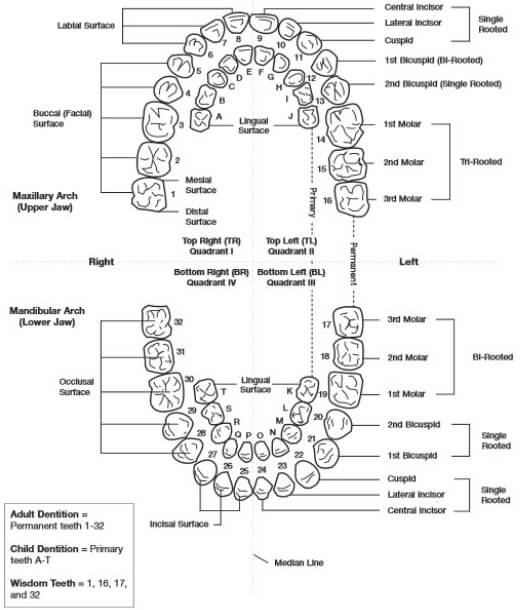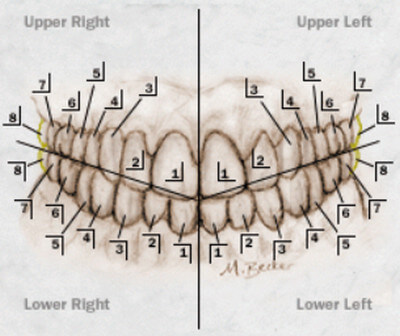How Are Teeth Numbered ?
Teeth Numbers
Teeth are very important parts that serve as grinding apparatus in the oral cavity.
They are fixed in the jaw. Human teeth are diphyodont, i.e. they are replaced only once in the lifetime while teeth of nonmammalian vertebrates are polyphydont, i.e. they are replaced throughout life.
The different types of teeth in a human are named:
- Incisor – the cutting teeth with chisel like crown
- Canine–the tearing teeth with conical or rugged crown
- Premolar– with 2 cusps, hence they are also called bicuspids
- Molar– the grinding teeth with square crown with 4-5 cusps [animated]
Teeth Arrangement
In adults, the permanent teeth are arranged from central to lateral as follows:
Number of Teeth in Normal Adult – 32
|
Upper |
Upper Jaw – Left |
||||||||||||||
| 3M | 2M | 1M | 2PM | 1PM | C | LI | CI | CI | LI | C | 1PM | 2PM | 1M | 2M | 3M |
| 3M | 2M | 1M | 2PM | 1PM | C | LI | CI | CI | LI | C | 1PM | 2PM | 1M | 2M | 3M |
|
Lower |
Lower Jaw – Left |
||||||||||||||
CI-central incisor; LI-lateral incisor; C- canine; PM- Premolar; M- Molar

Picture 1 : Tooth Arrangement Chart
Image Source: ameritasgroup.com
Types of Teeth
Primary dentition
The first set of teeth erupting soon after birth is called deciduous teeth or milk teeth or temporary teeth. They are 20 in number and each quadrant has 5 teeth arranged as : 2 Incisors – Canine – 0 Premolars – 2 Molars. The teeth in the lower jaw erupt earlier than those in upper jaw except Lateral incisor. The first deciduous teeth are the lower central incisors which erupt at about 6th month.
Permanent Teeth
The 2 types of permanent teeth are superadded permanent teeth, which have no deciduous predecessor and erupt behind a deciduous teeth and successional permanent teeth, which erupt in place of the deciduous teeth after they have fallen.
All the 12 permanent molars are superadded permanent teeth. The 20 left are successional permanent teeth in which the permanent premolars erupt in place of deciduous molars.
The permanent teeth are arranged in each quadrant as : 2 Incisors – 1 Canine – 2 Premolars – 3 Molars from central to lateral.
Teeth Numbering System
The numbering of teeth is done to indicate the location of a tooth, just like the chemical symbols for elements. Similar to finding a route to a destination, the numbering can be done in numerous ways. The widely used systems are:
- Universal Numbering System
- Palmer Notation Method
- FDI System
Universal Numbering System
In this system, the teeth in the upper jaw are numbered 1-16 from right to left and teeth in the lower jaw are numbered 17 – 32 from left to right.

Picture 2 : Universal Numbering System
Image Source: simplestepsdental.com
Permanent teeth
|
Upper Jaw – Right |
Upper Jaw – Left |
||||||||||||||
|
3M |
2M |
1M |
2PM |
1PM |
C |
LI |
CI |
CI |
LI |
C |
1PM |
2PM |
1M |
2M |
3M |
|
1 |
2 |
3 |
4 |
5 |
6 |
7 |
8 |
9 |
10 |
11 |
12 |
13 |
14 |
15 |
16 |
|
32 |
31 |
30 |
29 |
28 |
27 |
26 |
25 |
24 |
23 |
22 |
21 |
20 |
19 |
18 |
17 |
|
3M |
2M |
1M |
2PM |
1PM |
C |
LI |
CI |
CI |
LI |
C |
1PM |
2PM |
1M |
2M |
3M |
|
Lower Jaw – Right |
Lower Jaw – Left |
||||||||||||||
Deciduous Teeth
|
Upper Jaw – Right |
Upper Jaw – Left |
||||||||
|
2M |
1M |
C |
LI |
CI |
CI |
LI |
C |
1M |
2M |
|
A |
B |
C |
D |
E |
F |
G |
H |
I |
J |
|
T |
S |
R |
Q |
P |
O |
N |
M |
L |
K |
|
2M |
1M |
C |
LI |
CI |
CI |
LI |
C |
1M |
2M |
|
Lower Jaw – Right |
Lower Jaw – Left |
||||||||
In universal system, upper left canine is depicted as 11 for permanent teeth and H for deciduous teeth [simple].
Palmer Notation Method
In this system, teeth are numbered from central to lateral in each quadrant from 1-8 and the quadrants are depicted by the symbols (┘└ ┐┌).
Picture 3 : Palmer Notation Method
Image Source: simplestepsdental.com
Permanent Teeth
|
1 – |
2 – Upper Jaw – |
||||||||||||||
|
3M |
2M |
1M |
2PM |
1PM |
C |
LI |
CI |
CI |
LI |
C |
1PM |
2PM |
1M |
2M |
3M |
|
8 |
7 |
6 |
5 |
4 |
3 |
2 |
1 |
1 |
2 |
3 |
4 |
5 |
6 |
7 |
8 |
|
8 |
7 |
6 |
5 |
4 |
3 |
2 |
1 |
1 |
2 |
3 |
4 |
5 |
6 |
7 |
8 |
|
3M |
2M |
1M |
2PM |
1PM |
C |
LI |
CI |
CI |
LI |
C |
1PM |
2PM |
1M |
2M |
3M |
|
4 – |
3 – Lower Jaw – |
||||||||||||||
Deciduous Teeth
|
5 – Upper Jaw – Right |
6 – Upper Jaw – Left |
||||||||
|
2M |
1M |
C |
LI |
CI |
CI |
LI |
C |
1M |
2M |
|
E |
D |
C |
B |
A |
A |
B |
C |
D |
E |
|
E |
D |
C |
B |
A |
A |
B |
C |
D |
E |
|
2M |
1M |
C |
LI |
CI |
CI |
LI |
C |
1M |
2M |
|
8 – Lower Jaw – Right |
7 – Lower Jaw – Left |
||||||||
In Palmer notation, the upper left canine is depicted as 3└ for permanent teeth and C└ for deciduous teeth [simple].
Haderup System
This system is similar to the Palmer notation except that it uses (+) signs for upper teeth and (-) sign for lower teeth.
Upper (+)
|
3M |
2M |
1M |
2PM |
1PM |
C |
LI |
CI |
CI |
LI |
C |
1PM |
2PM |
1M |
2M |
3M |
|
8 |
7 |
6 |
5 |
4 |
3 |
2 |
1 |
1 |
2 |
3 |
4 |
5 |
6 |
7 |
8 |
|
8 |
7 |
6 |
5 |
4 |
3 |
2 |
1 |
1 |
2 |
3 |
4 |
5 |
6 |
7 |
8 |
|
3M |
2M |
1M |
2PM |
1PM |
C |
LI |
CI |
CI |
LI |
C |
1PM |
2PM |
1M |
2M |
3M |
Lower (-)
FDI System
This system numbers the teeth in the same way as Palmer Notation with an additional numbering of the quadrants. The quadrant numbering starts from upper right quadrant and goes clockwise.
Permanent Teeth
| 1 – Upper Jaw – Right |
2 – Upper Jaw – Left | ||||||||||||||
| 3M | 2M | 1M | 2PM | 1PM | C | LI | CI | CI | LI | C | 1PM | 2PM | 1M | 2M | 3M |
| 8 | 7 | 6 | 5 | 4 | 3 | 2 | 1 | 1 | 2 | 3 | 4 | 5 | 6 | 7 | 8 |
| 8 | 7 | 6 | 5 | 4 | 3 | 2 | 1 | 1 | 2 | 3 | 4 | 5 | 6 | 7 | 8 |
| 3M | 2M | 1M | 2PM | 1PM | C | LI | CI | CI | LI | C | 1PM | 2PM | 1M | 2M | 3M |
|
4 – |
3 – Lower Jaw – Left |
||||||||||||||
Deciduous Teeth
|
5 – Upper Jaw – Right |
6 – Upper Jaw – Left |
||||||||
|
2M |
1M |
C |
LI |
CI |
CI |
LI |
C |
1M |
2M |
|
5 |
4 |
3 |
2 |
1 |
1 |
2 |
3 |
4 |
5 |
|
5 |
4 |
3 |
2 |
1 |
1 |
2 |
3 |
4 |
5 |
|
2M |
1M |
C |
LI |
CI |
CI |
LI |
C |
1M |
2M |
|
8 – Lower Jaw – Right |
7 – Lower Jaw – Left |
||||||||
In FDI system, 23 is the upper left canine tooth for permanent teeth and 63 for deciduous teeth [American].
Modified FDI System
All aspects of FDI system remains the same except that the quadrants are numbered from left upper quadrant and the numbering goes anticlockwise.
|
2 – |
1 – Upper Jaw – Left |
||||||||||||||
|
3M |
2M |
1M |
2PM |
1PM |
C |
LI |
CI |
CI |
LI |
C |
1PM |
2PM |
1M |
2M |
3M |
|
8 |
7 |
6 |
5 |
4 |
3 |
2 |
1 |
1 |
2 |
3 |
4 |
5 |
6 |
7 |
8 |
|
8 |
7 |
6 |
5 |
4 |
3 |
2 |
1 |
1 |
2 |
3 |
4 |
5 |
6 |
7 |
8 |
|
3M |
2M |
1M |
2PM |
1PM |
C |
LI |
CI |
CI |
LI |
C |
1PM |
2PM |
1M |
2M |
3M |
|
3 – Lower |
4 – Lower Jaw – Left |
||||||||||||||
Apart from these widely used systems there are other charting methods like the anatomical and diagrammatic systems which involve pictorial representation of the individual teeth. But they are cumbersome for routine use.
Also see : Supernumerary Teeth (Hyperdontia) and Frequently Asked Questions About Teeth and Dental Health
References
- Quizzes about Types of Teeth and Tooth
Identification and Numbering accessed on http://www.animated-teeth.com/questions-answers/definitions-tooth-numbering-quiz.htm - Tooth Numbering accessed on http://www.simplestepsdental.com/SS/ihtSSPrint/r.==/st.31843/t.31882/pr.3/c.308449.html
- Dental Numbering Systems accessed on http://www.americantooth.com/downloads/instructions/Dental_Sys_Permanent_Teeth.pdf
Published by Dr. Raj MD under Dental Health.
Article was last reviewed on August 6th, 2018.


